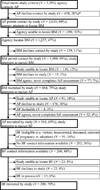The Early Growth and Development Study: a prospective adoption study from birth through middle childhood
- PMID: 23218244
- PMCID: PMC3572752
- DOI: 10.1017/thg.2012.126
The Early Growth and Development Study: a prospective adoption study from birth through middle childhood
Abstract
The Early Growth and Development Study is a prospective adoption study of birth parents, adoptive parents, and adopted children recruited in two cohorts (N = 561 triads). The primary study aims are to examine how family, peer, and contextual processes affect children's adjustment, and to examine their interplay (mediation, moderation) with genetic influences. Participants were recruited through adoption agencies located throughout the United States following the birth of a child. Assessments are ongoing, in 9-month intervals until the child reaches 3 years of age and in 1-year intervals thereafter through age 9. Data collection includes the following primary constructs: child temperament, social behavior, school performance, mental health, and health; birth and adoptive parent personality characteristics, mental health, competence, stress, health, context, substance use, parenting, and marital relations; and pregnancy use of drugs and maternal stress during pregnancy. DNA and salivary cortisol samples have also been collected. Analyses have indicated evidence for genotype-environment interactions during early childhood. Study procedures, sample representativeness (including tests of potential confounds in the adoption design), and an overview of findings to date are summarized, and future plans are described.
Figures


Similar articles
-
The Early Growth and Development Study: A Dual-Family Adoption Study from Birth Through Adolescence.Twin Res Hum Genet. 2019 Dec;22(6):716-727. doi: 10.1017/thg.2019.66. Epub 2019 Sep 17. Twin Res Hum Genet. 2019. PMID: 31526412 Free PMC article.
-
The Quebec Newborn Twin Study at 21.Twin Res Hum Genet. 2019 Dec;22(6):475-481. doi: 10.1017/thg.2019.74. Epub 2019 Oct 21. Twin Res Hum Genet. 2019. PMID: 31630700
-
The early growth and development study: a prospective adoption design.Twin Res Hum Genet. 2007 Feb;10(1):84-95. doi: 10.1375/twin.10.1.84. Twin Res Hum Genet. 2007. PMID: 17539368 Free PMC article.
-
Genetic expression outside the skin: clues to mechanisms of Genotype x Environment interaction.Dev Psychopathol. 2007 Fall;19(4):1005-27. doi: 10.1017/S0954579407000508. Dev Psychopathol. 2007. PMID: 17931431 Free PMC article. Review.
-
Are there genetic influences on addiction: evidence from family, adoption and twin studies.Addiction. 2008 Jul;103(7):1069-81. doi: 10.1111/j.1360-0443.2008.02213.x. Epub 2008 May 20. Addiction. 2008. PMID: 18494843 Review.
Cited by
-
Annual Research Review: Towards a deeper understanding of nature and nurture: combining family-based quasi-experimental methods with genomic data.J Child Psychol Psychiatry. 2023 Apr;64(4):693-707. doi: 10.1111/jcpp.13720. Epub 2022 Nov 15. J Child Psychol Psychiatry. 2023. PMID: 36379220 Free PMC article. Review.
-
Accounting for the shared environment in cognitive abilities and academic achievement with measured socioecological contexts.Dev Sci. 2019 Jan;22(1):e12699. doi: 10.1111/desc.12699. Epub 2018 Aug 16. Dev Sci. 2019. PMID: 30113118 Free PMC article.
-
Examining Morning HPA Axis Activity as a Moderator of Hostile, Over-reactive Parenting on Children's Skills for Success in School.Infant Child Dev. 2018 Jul-Aug;27(4):e2083. doi: 10.1002/icd.2083. Epub 2018 Feb 22. Infant Child Dev. 2018. PMID: 30147452 Free PMC article.
-
Parental Depression, Overreactive Parenting, and Early Childhood Externalizing Problems: Moderation by Social Support.Child Dev. 2019 Jul;90(4):e468-e485. doi: 10.1111/cdev.13027. Epub 2018 Feb 20. Child Dev. 2019. PMID: 29460308 Free PMC article.
-
Longitudinal Associations of Sleep Duration, Morning and Evening Cortisol, and BMI During Childhood.Obesity (Silver Spring). 2019 Apr;27(4):645-652. doi: 10.1002/oby.22420. Epub 2019 Feb 28. Obesity (Silver Spring). 2019. PMID: 30816633 Free PMC article.
References
-
- Birch LL, Davison KK. Family environmental factors influencing the developing behavior controls of food intake and childhood overweight. Pediatric Clinics of North America. 2001;48:893–907. - PubMed
-
- Bramlett MD. The national survey of adoptive parents: Benchmark estimates of school performance and family relationship quality for adopted children. 2011 Retrieved from http://aspe.hhs.gov/hsp/09/NSAP/Brief3/rb.shtml.
-
- Button TMM, Scourfield J, Martin N, Purcell S, McGuffin P. Family dysfunction interacts with genes in the causation of antisocial symptoms. Behavior Genetics. 2005;35:115–120. - PubMed
Publication types
MeSH terms
Grants and funding
LinkOut - more resources
Full Text Sources
Medical

